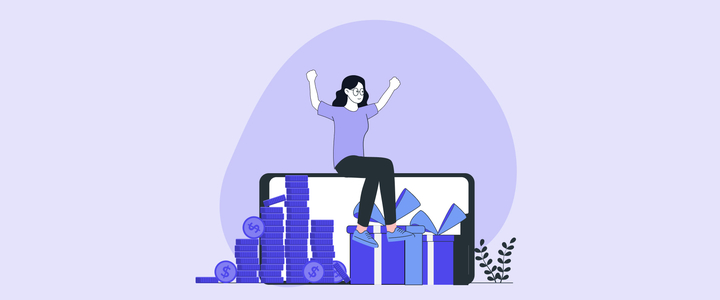Launching a loyalty program is just the beginning. The real challenge? Managing it effectively.
Nearly 70% of consumers agree that their loyalty program management is more difficult to maintain than ever before. So, managing a loyalty program is not just set-it-and-forget. It requires much more: customer centric strategy, focus, and the right tools.
And with these in mind, we have compiled this blog with 10 essential loyalty program management practices and best loyalty software solutions.
Let’s start.
Create and manage loyalty programs with WPLoyalty’s customizable campaigns to acquire and retain loyal customers.
What is Loyalty Program Management?
Loyalty program management is the process of designing, implementing, and optimizing customer loyalty programs to improve customer acquisition and retention.
Loyalty management ensures the loyalty campaigns run smoothly across all customer touchpoints—online and offline—through the use of loyalty management solutions.
The core functions in managing a successful loyalty program, includes:
- Strategic loyalty campaign planning and goal setting
- Loyalty Program design and reward structure development
- Technology implementation and integration
- Customer data analysis and segmentation
- Ongoing optimization and performance tracking
- Customer communication and engagement
Why is Managing Loyalty Programs Important?
Managing loyalty programs is important because it:
- Increases Customer Retention: Loyalty management directly impacts customer retention rates. According to research by Bain & Company, a 5% increase in customer retention can boost profits by 25% to 95%.
- Maximizes ROI: Proper management ensures that the loyalty system’s budget is spent wisely, improving return on investment.
- Boosts Customer Lifetime Value (CLV): When loyalty programs are continuously managed, it leads to repeat purchases that increase CLV in the long run.
- Drives Customer Engagement: By regularly updating and improving loyalty incentives, businesses can maintain high levels of customer engagement and reduce churn.
10 Best Practices of Loyalty Program Management
- Define Clear Objectives for Loyalty Program
- Customize Loyalty Rewards to Reduce Churn
- Use Data-Driven Insights and Customer Behavior
- Use CRM Integration to Build Customer Relationships
- Create a Multi-Tiered Reward Structure
- Optimize the Onboarding Process for Loyalty Program Members
- Implement Omnichannel Engagement Strategies
- Automate Loyalty Program Process with Right Software
- Track Key Metrics to Measure Loyalty Program’s Progress
- Constantly Adapt and Improve Loyalty Programs
1. Define Clear Objectives for Loyalty Program
Set specific, measurable goals aligned with your business objectives. Don’t just aim for “increased loyalty” – target concrete metrics.
Example objectives:
- Increase customer acquisition rate by 10% within this quarter.
- Increase customer retention rate by 15% within 12 months.
- Boost average order value by 20% for loyalty program members.
- Achieve a 25% increase in customer lifetime value for loyal customers.
How to do it?
- Use the SMART framework (Specific, Measurable, Achievable, Relevant, Time-bound).
- Align with overall business KPIs.
- Involve stakeholders from different departments (marketing, sales, customer service).
2. Customize Loyalty Rewards to Reduce Churn
Customizing loyalty rewards help to manage and retain customers on a personal level. Generic rewards will not appeal to all customers, leading to low engagement.
Action steps:
- Conduct customer surveys to understand reward preferences.
- Analyze purchase history to identify popular products for rewards.
- Offer a mix of transactional (discounts, free products) and experiential rewards (early access, exclusive events).
How to do it?
- Set up A/B testing for different reward structures. For instance, test whether offering a 10% off coupon vs. free shipping has a higher redemption rate.
- Provide Multiple Redemption Options and allow customers to choose between the loyalty rewards.
- Regularly update reward offerings based on customer feedback and redemption data.
3. Use Data-Driven Insights and Customer Behavior
Understanding customer behavior allows you to optimize your loyalty efforts for maximum engagement and return on investment (ROI).
Key areas for data-driven optimization:
- Analyze redemption patterns to identify most/least popular rewards.
- Evaluate customer progression through tiers and optimize if needed.
- Measure open rates and engagement to find the sweet spot.
How to do it?
- Implement RFM (Recency, Frequency, Monetary) analysis for customer segmentation.
- Use cohort analysis to track loyalty program impact over time.
- Use loyalty management software to segment customers (like frequent shoppers, high-value customers, occasional shoppers).
4. Use CRM Integration to Build Customer Relationships
Integrate your loyalty program with your CRM system for a holistic view of customer interactions and preferences.
Integration benefits:
- Unified customer profiles for personalized communication.
- Automated loyalty point updates and reward notifications.
- Seamless customer service experience across all touchpoints.
How to do it?
- Choose a loyalty program management software with robust API capabilities.
- Map out data flow between systems to ensure consistency.
- Train staff on the integrated system to leverage combined insights.
5. Create a Multi-Tiered Reward Structure
Implement a tiered reward system and offer progressively better rewards as they move up through different tiers.
Tier structure example:
- Bronze: 0-500 points (2% discount).
- Silver: 501-1000 points (3% discount + free shipping).
- Gold: 1001-2000 points (5% discount + free shipping + freebies).
- Platinum: 2000+ points (7% discount + free shipping + freebies + early access).
How to do it?
- Ensure clear, achievable progression between tiers.
- Reward customers at each level up with escalating discounts.
- Notify tier status and progress regularly to loyalty members.
- Consider time-bound tier statuses to encourage consistent engagement.
Create multi-tiered loyalty programs easily with WPLoyalty’s pre-built achievement campaign.
6. Optimize the Onboarding Process for Loyalty Program Members
The first interaction determines whether customers stay active or drop off. So, it is essential to have a smooth onboarding process for new members.
Key onboarding elements:
- Simple registration process (ideally one-click or auto-enrollment with purchase).
- Immediate reward or bonus points for signing up.
- Clear explanation of program benefits and how to earn/redeem points.
How to do it?
- Implement a welcome email series explaining loyalty program features.
- Use gamification elements (e.g., a tutorial quest) to engage new members.
- Set up triggered notifications for first point earn and redemption milestones.
7. Implement Omnichannel Engagement Strategies
Customers today interact with brands in-store, online, via mobile applications, and through social media. Omnichannel loyalty allows earning and redemption at all those touch points.
Omnichannel tactics:
- Sync point balances and redemption options across online and in-store (if applicable) channels.
- Enable point earning and redemption through mobile app, website, and in-store.
- Provide real-time updates on point balances across all platforms.
How to do it?
- Use a loyalty management platform with robust API integrations.
- Implement a unified customer ID system across all channels.
- Use location-based technology for personalized in-store loyalty experiences.
8. Automate Loyalty Program Process with Right Software
Automation saves time and improves accuracy when managing a loyalty program.
Key automation areas:
- Point calculation and allocation.
- Reward fulfilment and notification.
- Tier status updates.
- Personalized offer generation.
How to do it?
- Select a loyalty program management software with strong automation capabilities.
- Trigger customized emails for point balance updates, tier changes, and available rewards.
- Use AI-powered tools for real-time, personalized offer generation.
- Implement chat bots or live chat plugins for instant loyalty program support and information.
9. Track Key Metrics to Measure Loyalty Program’s Progress
Measuring the right metrics is very essential in providing your program’s performance assessment and areas for improvement.
Key metrics to track:
- Redemption rate: Aim for at least 25% to ensure program value.
- Active engagement rate: Target 50% or higher for program health.
- Customer Lifetime Value (CLV): Measure increase in CLV for loyalty program members vs non-members.
How to do it?
- Set up a loyalty program dashboard with real-time KPI tracking
- Conduct regular A/B tests on program elements (e.g., reward options, point expire policies)
- Implement Net Promoter Score (NPS) surveys specifically for loyalty program members
10. Constantly Adapt and Improve Loyalty Programs
A well-managed loyalty program never stands still. It should be updated and improved periodically with the consumer’s feedback, changing eCommerce trends, and data from loyalty campaign performance.
Adaptation strategies:
- Conduct quarterly program reviews.
- Stay updated on industry trends and competitor offerings.
- Regularly survey loyalty members for customer satisfaction and improvement suggestions.
How to do it?
- Establish a dedicated loyalty program management team.
- Set up a calendar for regular program updates (e.g., new rewards, seasonal promotions).
- Consider forming a customer advisory board for program input.
- Keep an eye on what your competitors are doing with their loyalty management solutions.
5 Types of Loyalty Management Solution and Which is Right for You?
1. Point-Based Loyalty Programs
- How It Works: With each purchase, customers earn points that they can redeem for rewards such as discounts on purchases, free shipping or even free products.
- Best For: Retailers, quick-service restaurants, and ecommerce businesses.
- Key Benefit: Make customers do frequent transactions and increase purchase frequency. Reward point systems keep customers coming back, especially for businesses where average order value (AOV) is lower, but purchases are frequent. Being quick to reach the reward, customers make smaller purchases more frequently.
- Example: In Starbucks Rewards, the reward points rapidly accumulate with frequent purchases, yet customers will keep returning to the store in the hope of gaining that next free coffee.
2. Tiered Loyalty Programs
- How It Works: Customers receive escalating rewards as they reach higher tiers through more purchases or higher spending.
- Best For: Luxury brands, high-ticket items, and subscription-based businesses.
- Key Benefit: Builds long-term customer engagement and sales at higher price points. Tiered loyalty programs work well for businesses that want to extend customer lifetime value (CLV) by rewarding loyalty and increasing average order value (AOV). Customers aim for higher tiers, leading them to spend more over time.
- Example: Sephora’s Beauty Insider program reaps larger annual purchases, as customers get premium perks (like exclusive events) as they climb tiers.
3. Paid or Subscription-Based Loyalty Programs
- How It Works: Customers pay a fee to access exclusive benefits such as free shipping, special discounts, or premium services.
- Best For: Brands with frequent, loyal customers who see immediate value, such as eCommerce giants, grocery delivery services, or subscription businesses.
- Key Benefit: Locks in customers by providing continuous, high-value benefits. Paid loyalty programs make customers invest upfront and then feel motivated to maximize their membership value. These programs address a key customer pain point—reducing churn. Since customers have already invested to access the benefits, they feel naturally inclined to stay loyal.
- Example: Amazon Prime members are more likely to shop on Amazon for convenience and fast shipping, reducing their likelihood of shopping on competitor platforms.
4. Value-Based Loyalty Programs
- How It Works: The business will donate to a cause or charity based on the customer’s purchase instead of giving a discount or points.
- Best For: Brands targeting socially conscious consumers, especially in retail, fashion, or food industries.
- Key Benefit: Aligns your brand with customer values, driving deeper emotional connections. This type of loyalty program is particularly effective for purpose-driven brands. This type of loyalty program solution is useful to a purpose-driven brand. Customers feel they are doing something bigger than themselves with each purchase. It meets the growing consumer demand for socially responsible brands.
- Example: TOMS’s one-for-one model makes the customer part of a positive impact. Every purchase results in a very tangible good deed, such as providing shoes to those in need.
5. Hybrid Loyalty Programs
- How It Works: Combines multiple types of loyalty programs (e.g., points, tiers, subscriptions) into one.
- Best For: Complex businesses that span multiple customer segments, such as omnichannel retailers, fashion brands, or large-scale ecommerce platforms.
- Key Benefit: Offers flexibility to meet diverse customer preferences and maximizes engagement. The hybrid program allows a company to reach a variety of customers such as high-spenders, frequent shoppers, or socially-conscious buyers through the use of a number of loyalty mechanisms.
- Example: Nordstrom’s Nordy Club program combines points-based rewards with loyalty tiers, and also offers “Cardmember exclusives”.
Choosing the Right Solution for You:
To select the best loyalty management solution, evaluate your business model, customer base, and long-term goals:
- For businesses with frequent, small transactions (e.g., retail or QSR), Point-Based Loyalty Programs help drive repeat purchases.
- High-ticket or luxury brands benefit most from Tiered Loyalty Programs, encouraging larger spending over time.
- If your customers already demonstrate strong loyalty, a Paid/Subscription-Based Loyalty Program is ideal for locking in their engagement.
- For purpose-driven brands, Value-Based Loyalty Programs align your business with social causes.
- Hybrid Programs are best for large or diverse businesses needing flexibility across customer types.
5 Best Customer Loyalty Programs Management Software
Loyalty program management software comes in two main flavors: in-house solutions and third-party platforms.
With in-house development, one can manage the loyalty system but it is challenging to adapt due to the fast changes that technology and integration require.
On the other hand, third-party loyalty software usually have mature and ready-to-use solutions to numerous business requirements.
The 5 Best Loyalty Programs Management Software:
1. WPLoyalty
WPLoyalty is the best management software for customer loyalty programs that helps you create and manage loyalty programs.
With this software, you can create, manage and track loyalty campaigns like point-based systems, referral programs, sign ups, product reviews, social shares, birthday rewards, daily login and tiered loyalty systems.
This loyalty management platform comes with a detailed analytics and reporting dashboard, helping you to track each loyalty campaign.
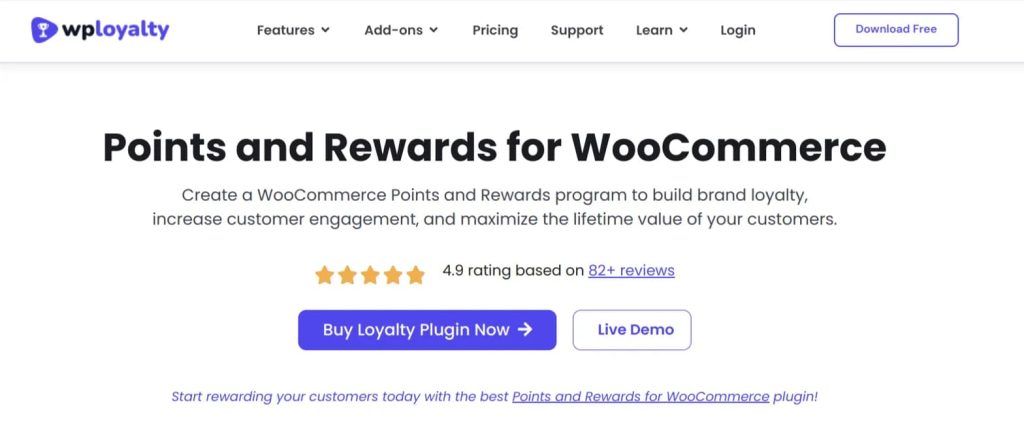
Key features
- Customizable Loyalty Campaign Creation
- Points Management
- Rewards Management
- Tiered loyalty campaigns
- Customer Segmentation through filters
- Automated email notifications
- Point Expiry System
- Multi-Currency Support
- Multilingual Compatibility
Pricing
- Starter – $99/year
- Professional – $129/year
- Agency – $199/year
Manage points distribution, track rewards, and send personalized notifications with WPLoyalty’s points and rewards loyalty campaigns.
2. Loyalty Lion
LoyaltyLion is a data-driven loyalty and rewards management software for brands using Shopify. It offers a variety of point-earning and reward-redemption options.
You can create customized loyalty programs that reward customers for purchases, reviews, social engagement, and more. Its interface is user-friendly, with out-of-the-box rules and the ability to create bespoke activities.
It integrates seamlessly with Klaviyo, Shopify, Magento, and Gorgias.
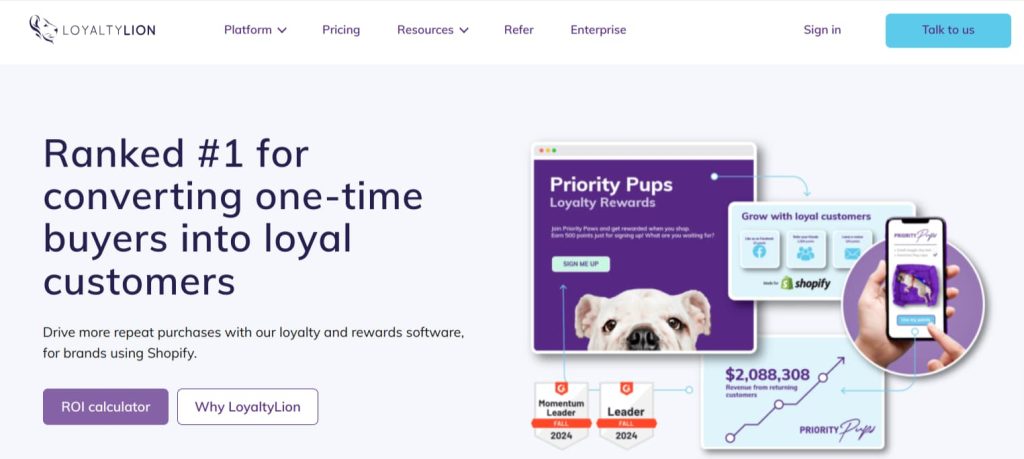
Key Features
- Point-based system for various activities
- Referral Program
- Tiered Loyalty System
- Custom Rewards
- Review-based rewards
- Automated email notifications
- In-store points with POS integration
- VIP Tiers for premium customers
- Early Access and Event Invitations
- API for custom activities
Pricing
- Classic: $199/month for 1,000 orders per month. Pricing differs based on your monthly order volume.
- Advanced: Custom pricing
- Plus: Custom pricing
3. Open Loyalty
Open Loyalty is an API-first loyalty software platform with scalable loyalty program solutions. It offers powerful tools to create sophisticated loyalty and gamification programs, concentrated in flexibility and integration capabilities.
With Open Loyalty’s integration layer, you can easily add loyalty blocks to platforms while having full ownership of your customer data.

Key Features
- Trigger-condition-effect logic
- Extensive gamification features (points, tiers, rewards, badges, etc.)
- Advanced campaign builder
- Webhooks integration tools
- Comprehensive API access
- Referral-based rewards
- Data export via S3
Pricing
- Open Loyalty offers custom pricing based on project requirements.
4. LoyaltyXpert
LoyaltyXpert is a Channel Loyalty Program Platform for building loyalty with channel partners, influencers, and end customers.
The platform has the ultimate goal of helping organizations use their sales data-in other words, drive incremental purchases and improve channel partner relationships.
LoyaltyXpert enables the firms to design and operate loyalty programs with value positioned beyond mere offers, discounts, and rather with a strong data-driven approach and robust analytics.
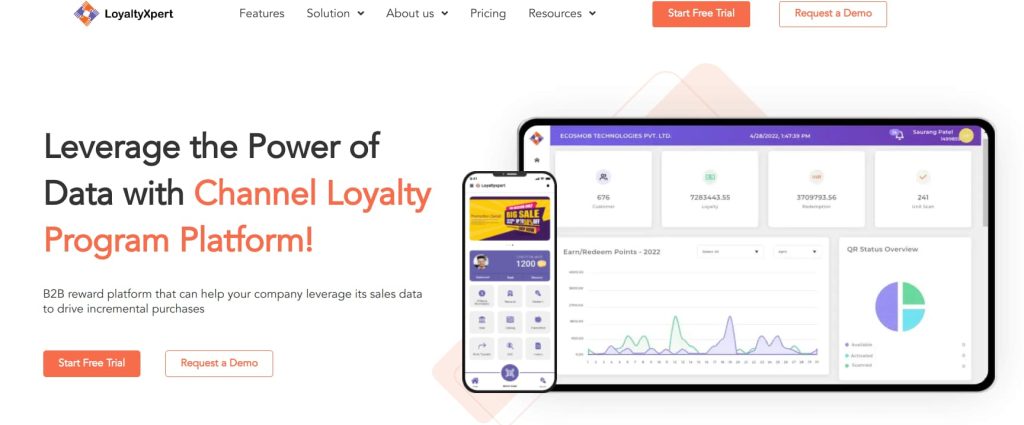
Key features
- Multiple & flexible options for program setup
- Define multiple schemes for different partner segments
- Insights & analytics for data-driven decisions
- Personalization options for tailored experiences
- CRM system integration for unified customer data
- Extensive rewards catalog
- Omnichannel approach for consistent experiences
Pricing
LoyaltyXpert offers two pricing models:
- SaaS: A full-featured solution for building loyalty projects.
- PaaS: A customizable service model tailored to specific business needs.
5. Antavo
Antavo is an enterprise-level loyalty program management platform that uses AI technologies to create customized loyalty solutions. This software offers end-to-end technology for managing the entire lifecycle of loyalty programs.
The Antavo platform helps build the loyalty program 10 times faster and runs on what they say is the most powerful AI-driven engine in the market.
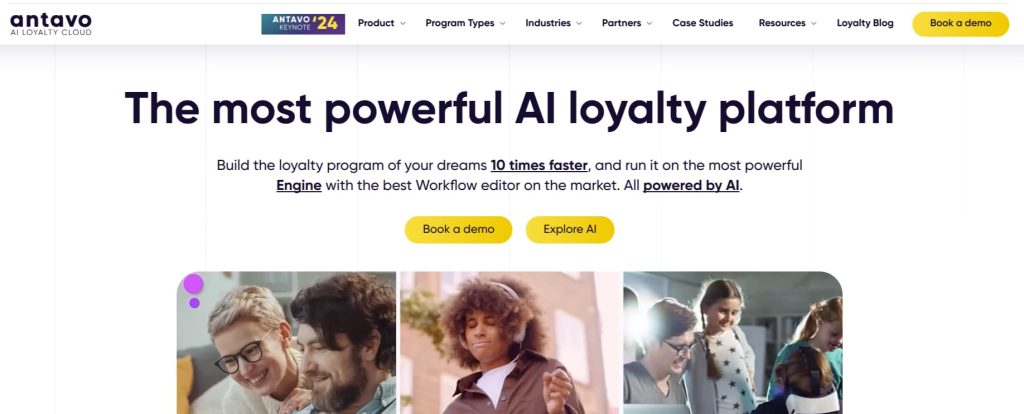
Key features
- AI-powered loyalty program management
- End-to-end lifecycle management for loyalty programs
- Gamification, automation, tiered, hybrid programs
- Enterprise-level scalability
- Composable loyalty technology
- No-code Workflow editor
- Continuous innovation with frequent updates
- Accessible loyalty technology with agnostic AI
Pricing
- Antavo offers custom “True Cloud Pricing” for its loyalty management platform.
- Interested customers must submit a request form with their details to receive a personalized quote.
How to Choose the Best Loyalty Program Management Software?
When selecting loyalty program software, focus on the following key aspects:
- Seamless integration with existing eCommerce platforms and CRM systems.
- Advanced analytics for customer behavior tracking and loyalty campaign performance.
- Flexibility to customize loyalty program rules, tiers, and reward structures.
- AI-driven personalization for loyalty rewards and communications.
- Omnichannel capabilities for consistent customer experience.
- Scalability to accommodate business growth and increasing complexity.
- Robust security and compliance with data protection regulations.
- Intuitive user interface for both customers and administrators.
- Predictable and affordable pricing.
Get started with WPLoyalty – the loyalty program management software’s loyalty programs and manage your campaigns effortlessly.
Final Words
We’ve covered a lot of ground in this guide, from loyalty program management best practices to software solutions. Now it’s time to put that knowledge into action.
Here are a few practical steps to consider:
- Evaluate your current or planned loyalty program against the 10 best practices we’ve discussed. Where are the gaps?
- Take a critical look at your technology stack. Is it supporting your loyalty efforts effectively?
- Consider how a specialized solution like WPLoyalty could streamline your loyalty management.
Frequently Asked Questions
A loyalty program manager designs, implements, and optimizes customer loyalty initiatives. They analyze data, create engaging rewards, manage member communications, and ensure the program aligns with business goals to drive customer retention and increase revenue.
The three main components of loyalty are:
1. Behavioral loyalty: Repeat purchases and interactions
2. Attitudinal loyalty: Positive feelings and preference for the brand
3. Cognitive loyalty: Conscious decision to choose the brand over competitors
The three R’s of loyalty programs are:
1. Rewards: Offering valuable incentives for customer engagement
2. Recognition: Acknowledging and appreciating customer loyalty
3. Relevance: Ensuring the program and its benefits resonate with customers’ needs and preferences
